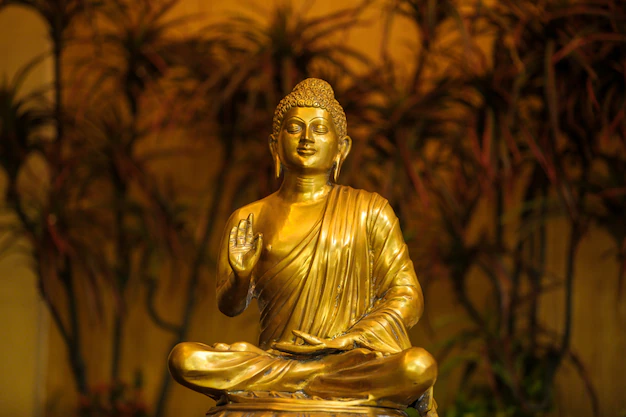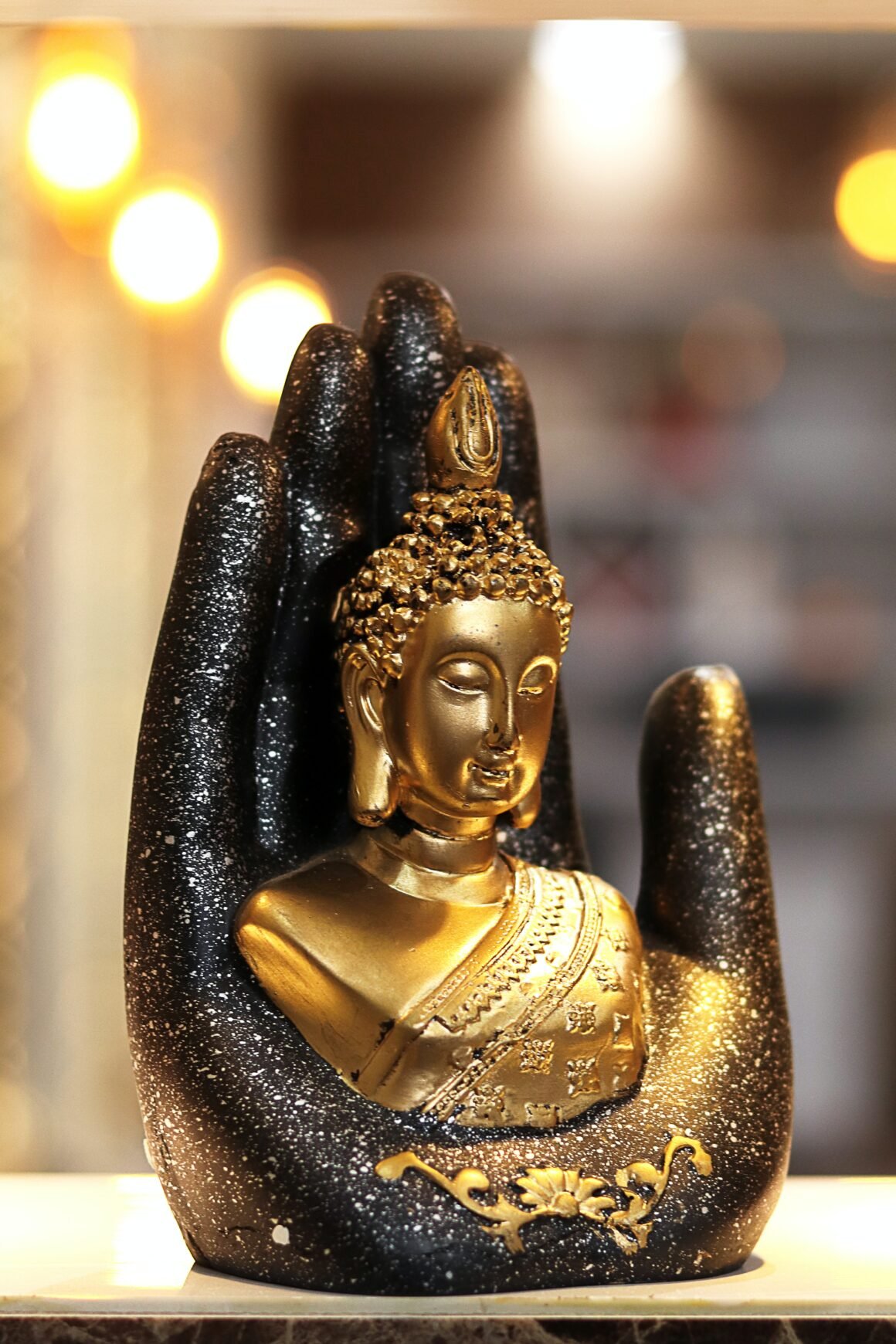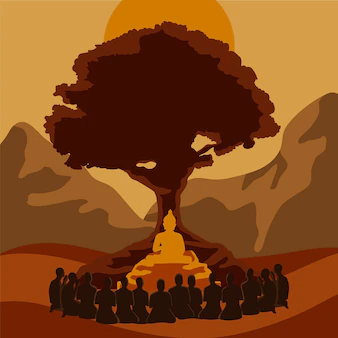This record of the pilgrimage I made to the Buddhist places of worship in India was first written as a series of newspaper articles.
I have subsequently expanded and elaborated on the material, as I had to leave out information and description for want of space.
I was accompanied by one other woman, my cousin Swarna and we made the whole pilgrimage, by ourselves. But it was well worth it.
We took our time and stayed an extra day or two if we wished to, in the course of a schedule which I planned for flexibility. It was also quite cheap.
But, I have to warn pilgrims that it was no easy trip and it needs stamina and good health to withstand the exhaustion of long journeys.
Such a trip is not for people who are not in the pink of health.
This is a journalistic exercise. It intends to give the colour, the flavour and the ambience of these sacred places and also some idea of the problems one might encounter during the pilgrimage.
Passage to Budha Gaya
We arrived in Varanasi in the night and at the Dak bungalow there was only one cottage left. The manager told the European couple who came with us from Calcutta (we had been wait-listed but managed to jump in), “I will give the cottage to the two Sri Lankan ladies and I’ll arrange another hotel for you.” The cottage was a bit ragged and the beds sagging, the toilet somewhat cobwebby, but tolerable. It was a blessing we got it because we felt safe at once. It was amply compensated for by the huge old garden with ancient trees, overhanging creepers and flowers and plenty of birds and squirrels.You could squat on the floor of the verandah in the mornings and sip your tea and watch the birds. We got plenty of boiling water for tea and for drinking. We preferred the flavour of our own tea and in many places, Indians do not brew the tea but cook it.
In a journey full of incidents, small shocks and much kindness from ordinary Indians, the Indian bureaucrat is an incredible phenomenon. Put him behind a desk or counter, he becomes a stone robot, mouthing information jerkily and reluctantly. Put the same man on the railway platform or anywhere else and he will go out of his way to help you. If you have not bought a round-tour tourist ticket for dollars, then the first thing you do is buy your railway ticket to the next destination. The next morning we walked to the Varanasi station to book the berths. In a minute, were overwhelmed by an avalanche of men and metal-cycle rickshaw wallahs, three-wheelers, peddlers of fruit, betel, pottus and other geegaws, commuters, cows and dust. Aranath, 10 km. away from Varanasi is where you go first, the holiest of holy places where the Buddha preached his First Sermon in the deer park at Isipathana. We went by three-wheeler. There is a bus which stops further away from the ruins and temples.
All places of Buddhist worship, looked after by the Indian government, that I visited are immaculately kept. Saranath is a place of tranquillity, green with grass, dotted with ruins and remains of temples and monasteries, evocative of a long-gone civilization and its extraordinary sensitivity. In this cradle of Buddhism, much has been lost, but there is much to see. The Dhammeka and Dhammarajeka stupas, the Chankramana, where the Buddha walked in meditation, the archaeological museum, the Maha Bodhi Society library, and the Ashoka pillar with its Lion capital now in the museum. Saranath flourished from the 3rd century BC to 12 AD and reached its Zenith during the Gupta dynasty.
The Chinese monk, Hiuen Tsiang describes a monastery here with 1500 monks, magnificently built, a temple 60 metres high and many gilded Buddha statues in niches. Saranath is truly the cradle of Buddhism, where the Buddha attained Enlightenment and preached the Dhammacakkapavattana sutta, the First Discourse. The Mulagandakuti Vihara was built by Anagarika Dharmapala at Saranath in 1931 with contributions from Buddhists all over the world, but mainly from the American Buddhist, Ms Mary Foster. Sri Lankan Buddhists donated the beautiful doors and the portico. It was part of his quest to restore Buddhist places of worship to their former grace and excellence. The main shrine has been built over relics believed to be those of the Buddha. They were presented to the Mahabodhi Society by the Indian Viceroy, Lord Irwin. They were found in Taxila, Nagarjunikonda.

Pilgrims should spend some time looking at the paintings within the shrine by the Japanese artist Kosetu Nosu. The shrine itself is quite spacious. The paintings represent many events from the life of the Buddha – Mahamaya’s dream before conception; the birth of Prince Siddhartha; the Prince looking at his wife and child before his departure; the Buddha accepting food from Sujatha; Mara and his army; the conversion of Angulimala; the Buddha attaining Parinirvana etc.
The Anagariks’ ashes are entombed in a small stupa behind the shrine in this place which he did so much to save, among the numerous other sacred spots he stove to restore. It was here that Emperor Ashoka erected a pillar which warned monks and nuns against causing a schism in the Buddhist monastic order. The Ashoka pillar is reputed to be 12 metres high and the inscription on it says: ‘the Sangha cannot be split. Whoever, whether monk or nun causes a split in the Sangha must be made to wear white clothes, and live somewhere other than a monastery’.
After the passing away of the Buddha, there was a real danger of a schism in the Sangha. In fact, after the Third Council, a large number of monks were expelled. Throughout the centuries new shrines, temples, monasteries, edifices and ‘kutis’ for meditating monks have been added on to this huge complex. But what you see now are the ruins. Waves of Moghul invaders brought about the final destruction of Saranath around 1194 when thousands of monks were killed or forced to disrobe. After Emperor Ashoka visited Saranath he caused to be built the pillar in Deer Park. Its magnificent Lion capital has been broken off and now lies in the archaeological museum nearby. The pillar has an abacus on which are mounted four decorative stylized lions sit back to back. On the abacus, there are carved animals signifying the four directions: the elephant for the east, the horse for the south, the lion for the north and the bull, for the west.
The museum is exceptionally well-stocked and a visit to it is compulsory sightseeing. The collection housed in the museum includes, apart from the Lion Capital of Ashoka pillar, beautiful statues of the Buddha, of Prince Siddhartha and sculptures of the Wheel which, even in ancient India, was a symbol of power. There are also sculptures of monks and deer, and they are believed to symbolize what the Buddha thought a Buddhist should be a gentle person, quick and alert in mind and intelligent. Pilgrims can also have a look at the rare collection of Buddhist literature at the Mahabodhi museum nearby. It is here, seated in contemplation that you can recall the truths enunciated in the First Discourse. It encapsulated the foundation of Buddhist philosophy and, in Saranath, once you have stepped on its sacred soil, these Truths come to mind as the core of the Buddha’s teachings.
From Buddha Gaya, he came to Saranath and there he met his erstwhile friends, the five ascetics Kondanna, Bhaddia, Vappa, Mahanama and Assaji, who at first were displeased with him. The Buddha had rejected the extreme path of self-mortification that they had chosen. But the Buddha convinced them that the two extremes of self-torture and self-indulgence did not bring them release from suffering. They listened to him here in the Deer Park at Isipathana and were converted when he preached the Dhammacakkapavattana sutta extolling the meaning of the Four Noble Truths, the Noble Eightfold Path and the virtues of the Middle Path for one’s salvation. Dhammacakkapavattana means the Exposition of the Establishment of Wisdom. Dhamma may also be interpreted as Truth and Cakka as the Wheel. So we have the Turning or Establishment of the Wheel of Truth. Or it could be interpreted as the discourse setting in motion the Wheel of Dhamma. So as you have had the good fortune to stand on this hallowed soil, you may remember the summing up of that philosophy as told by the Dhammapada.

To cease from all evil. To cultivate good and to purify one’s mind. This is the advice of the Buddha. Soon after the conversion of several persons, some of whom became monks, the Buddha said to them; ‘Go forth for the good of the many, for the happiness of the many, out of compassion for the world, for the welfare, the good and the happiness of both gods and men. Let not two of you go in the same direction. Teach the Dhamma, which is beautiful in the beginning, beautiful in the middle and beautiful in the end. Many temples and monasteries were built here during and after the life time of the Buddha. But these had been put to the torch by the Moghul invaders. Sir Alexander Cunningham, who became Director General of the Indian Archeological Survey in 1861, found after excavation that many of these had been burnt down. An indication of the destruction of Buddhism and its monuments is evidenced by the fact that pillars, stones, brick, timber and masonry from buildings were used to build mosques and bridges etc.
It is recorded that in 1794 a local king, Maharaja Jagath Singhe had the Dhammarajika stupa, believed to mark the place where the Buddha delivered the first Discourse, demolished and the materials used to build a market in Varanasi. Saranath is a place where you must wander around, sit down and contemplate your surroundings, and quieten your mind by seeing and unseeing. It is very restful just to sit there. We sat down in the shade on bits of brickwork and rocks and let our minds go still and serene. Your mind reaches a level of peace and you arrive at a meditative state almost without knowing it. The immensity of that wisdom sinks into your mind and you feel a kind of renewal suffused with light and contentment. You can visit the Tibetan, Chinese and Jain temples and of course the Sri Lankan temple, where a kind Buddhist monk administered pansil to us, after taking us around. Invasion by the Moghuls had laid waste all the Buddhist places of worship, such as Buddha Gaya, Saranath, the Great university of Nalanda etc., they were in ruins and the jungles and desolation had overrun these sacred spots.
By the thirteenth century, the devastation and abandonment of many of these sites were complete. Buddhism faced its darkest era on the sub-continent at this time. The restoration of these places began with the arrival of the British. But it was Anagarika Dharmapala, who alerted the rest of the world in general and Buddhists in particular to the sad state into which these sites had fallen. Anagarika Dharmapala founded the Maha Bodhi Society whose main mission was the restoration of Buddha Gaya and other places of Buddhist worship in India. It was after Anagarika’s efforts that the Mulagandhakuti Vihare was built at Saranath and the most elegant and impressive Maha Bodhi Vihare at Buddha Gaya.
It is said that the Anagarika made a vow before the Bodhi tree at Buddha Gaya that he would even lay down his life to restore the temples of Buddha Gaya. It was in 1894 that the first organized group of pilgrims from Ceylon went to Buddha Gaya. Varanasi, like Naples, is a place you must see before you die. It is said to be contemporary of Nineveh and Thebes and is called Kashi or Light by the devout Hindu. The Buddha came here, (remember ‘yatagiva davasa Banaras nuwara Brahmadatta rajuge Kalayedi….) but Varanasi encapsulates the mysticism and ritual of Hinduism. By the Ganges riverfront Dasasomedh ghat, you could watch the brilliance of the rising sun at dawn, and the flickering boat lights at twilight. Here you view with fascination the cross-fertilization of religious and cultural practices superstitions and beliefs of thousands of years in one place. The bathers cleansing themselves of their sins in the water, muddy and obviously unclean; women dipping into the river with all their clothes on; praying sadhus and mendicants; lepers waving their stumpy limbs; peddlers shouting holy men shaving heads; other holy men sitting on cushions of the nail and other shaven heads and necks inscribed with the name of God looking like Egyptians tablets, befuddle your vision.

People tell you Varanasi is the cheapest place for silks. Don’t you believe it? Touts are plentiful and they harass you incessantly. Never speak to anybody. They will follow you, harass you and sing songs about silk factories. But any mention of the police has an electric effect. Vishvanath Golden temple is dedicated to Shiva, with its ornate interiors and age-old rituals. Vishvanath Gulli is where the silks and touts are. There was another Hindu temple which I visited during our stay in Varanasi. Unfortunately, I cannot remember its name. It was ancient and venerable with old shrines dotted throughout its premises. But I noticed that worshippers were few. What I do remember are the hordes of monkeys which dived into the canal running through the temple premises. They were everywhere.
On the banks of the Ganges, the brochures say that there is a Nepalese temple with erotic wood carvings. I did not know it at that time. The brochure reached me too late. Varanasi fascinates, infuriates, and dazes you. And now to Gaya, from whence we could go to Buddha Gaya. We were soon in the midst of a crow, which gathered and arbitrated vociferously and unintelligibly. I was quite sure that the red kerchief, who carried our luggage was a riverside thug, but I gave in- anything to get on that platform and in any case, he had our bags. Why did we bring so many things? Travel light. The red kerchief demanded Rs. 25 after we got to the platform in three minutes. That was too much. I shouted in broken Hindi. How I found the words I do not know, because now I forget the words for rogue, thief, etc. Two gentlemen came along, the same you might find behind a desk, asked me to pay him Rs.5 and hissed ‘Ja – oh Ja- oh’ at him and he vanished. No seats on the platform again; we sat on a plastic sheet opened our bath malla, sandwiched really, and giggled in relief.
On the train, Swarna clambered up onto a top berth, while mine was in the passageway above that of a venerable bearded swami. When I tried to climb up, there was a kusukusu kuttam. I was probably casting my shadow over his sacred person. Would I like a lower berth? Of course. A boy climbed up and I got the lowest berth. The train was arriving at Gaya at 1.30 a.m. and despite the berth attendant’s assurances that he would wake us, it was restless sleep. It would have been no joke if we were overcarried to Dhanbad, past Gaya.

And then the shock. I woke up and saw a man sitting at the foot of my bunk holding a gun. ‘Lay watura una’ and I must have automatically started saying ‘ithipiso bhagava arahan samma sambuddo…’The man stood up hurriedly and smiled unnerving me even more. Then I understood. I asked whether he was in Railway security or the Army. He said “Railway, railway” and hurried away. Only then did I realize that he had thought I was a man in a sarong, and the most elegant and impressive Maha Bodhi Vihare at Buddha Gaya.
It is said that the Anagarika made a vow before the Bodhi tree at Buddha Gaya that he would even lay down his life to restore the temples of Buddha Gaya. It was in 1894 that the first organized group of pilgrims from Ceylon went to Buddha Gaya. Varanasi, like Naples, is a place you must see before you die. It is said to be contemporary of Nineveh and Thebes and is called Kashi or Light by the devout Hindu. The Buddha came here, (remember ‘yatagiva davasa Banaras nuwara Brahmadatta rajuge Kalayedi….) but Varanasi encapsulates the mysticism and ritual of Hinduism.





